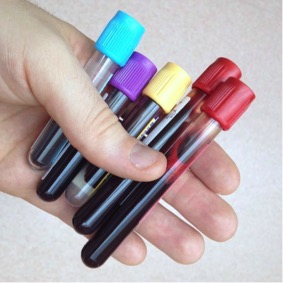Duchenne muscular dystrophy
Diagnosis
The mean age of diagnosis of DMD can vary from country to country, but the average is between 2-5 years. Signs and symptoms of DMD are present from the age of 2-4 years. Parents are often the first to notice differences in their child’s development compared to their peers.
The first step in reaching a diagnosis is a blood test to check creatine kinase (CK) levels. CK is a type of an enzyme that the muscles in the body need to function. The test measures the amount of an enzyme in the blood. CK is usually in the muscle, but the muscle releases CK into the blood when damage occurs.
In healthy people, CK can be a little higher after trauma or intramuscular injection. People with DMD often have CK levels 10-100 times the normal value. In boys with DMD CK levels can vary from one day to another. This can depend on how active the boy has been that day, but they are always raised. Normal CK levels exclude DMD as a diagnosis and a blood test is usually done first to rule this out.

Elevated CK levels may result in a referral to a specialised neuromuscular centre. The may also be a genetic test to identify the specific change in the DNA that causes DMD.
Genetic testing is important. It confirms the diagnosis and identifies the correct genetic mutation. Genetic testing will discriminate DMD from Becker, and other forms of muscular dystrophy. An accurate diagnosis is important for identifying the correct care and treatment. It is also necessary for referral to the appropriate clinical trials.
Most people will not need a muscle biopsy to receive a diagnosis of DMD. A biopsy is usually performed only if there is a high CK level and signs of muscle weakness, but no genetic mutations in the dystrophin gene. A muscle biopsy may also helpful when genetic testing does not identify the mutation.
A muscle biopsy involves the surgical removal of a small sample of muscle. Analysis of the sample shows if there is any dystrophin in the muscles. A muscle biopsy can diagnose other muscle problems if genetic testing has excluded DMD and BMD. There is usually no need to perform a muscle biopsy to discriminate DMD from BMD. The type of genetic mutation, and clinical signs can confirm the diagnosis.
After a DMD diagnosis, it is important to test the boy's mother for the mutation in the dystrophin gene. This will show whether she is a carrier, or not. If she is a carrier, genetic testing will identify other family members who are at risk of being carriers or having affected children. This helps to provide genetic counselling for future pregnancies.
Carriers of DMD and BMD can develop heart problems even if they do not have any symptoms. Monitoring is important so that they can receive heart treatment, if necessary.